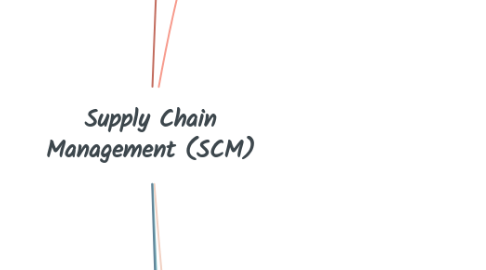
1. Overview
1.1. Definition
1.1.1. Management of the flow of goods and services from raw material acquisition to final product delivery.
1.2. Objectives
1.2.1. Efficiency Improvement
1.2.1.1. Streamline operations to minimize waste, reduce costs, and increase productivity.
1.2.2. Cost Reduction
1.2.2.1. Lower production and operational costs through optimized resource use, strategic sourcing, and inventory management.
1.2.3. Quality Enhancement
1.2.3.1. Ensure high standards of quality in products and services to meet customer expectations and reduce defects.
1.2.4. Customer Satisfaction
1.2.4.1. Deliver products and services that meet or exceed customer expectations in terms of quality, timeliness, and cost.
1.2.5. Flexibility and Responsiveness
1.2.5.1. Develop the ability to quickly respond to changes in market demand, supply disruptions, and other unforeseen challenges.
1.2.6. Risk Management
1.2.6.1. Identify, assess, and mitigate risks within the supply chain to prevent disruptions and maintain continuity.
1.2.7. Sustainability
1.2.7.1. Implement environmentally friendly practices and sustainable sourcing to minimize the ecological footprint of supply chain activities.
1.2.8. Innovation and Improvement
1.2.8.1. Continuously seek ways to innovate processes, products, and technologies to stay competitive and meet evolving market needs.
2. Key Components
2.1. Planning
2.1.1. Demand Forecasting
2.1.1.1. Predicting future customer demand using historical data, market trends, and statistical tools.
2.1.2. Supply Planning
2.1.2.1. Ensuring that resources are available to meet forecasted demand.
2.1.3. Inventory Management
2.1.3.1. Balancing the costs of holding inventory with the need to meet customer demand.
2.2. Sourcing and Procurement
2.2.1. Supplier Selection
2.2.1.1. Evaluating and choosing suppliers based on factors such as cost, quality, reliability, and service.
2.2.2. Procurement
2.2.2.1. Acquiring raw materials, components, or services needed for production.
2.2.3. Supplier Relationship Management
2.2.3.1. Maintaining and developing good relationships with suppliers to ensure continuous supply.
2.3. Manufacturing
2.3.1. Production Planning
2.3.1.1. Scheduling the production processes to ensure efficiency and meet demand.
2.3.2. Quality Control
2.3.2.1. Ensuring that the products meet certain standards and specifications.
2.3.3. Lean Manufacturing
2.3.3.1. Implementing strategies to reduce waste and improve efficiency.
2.4. Logistics
2.4.1. Transportation Management
2.4.1.1. Planning and controlling the movement of goods from suppliers to customers.
2.4.2. Warehouse Management
2.4.2.1. Managing the storage of goods to ensure they are available when needed.
2.4.3. Order Fulfillment
2.4.3.1. Completing customer orders accurately and efficiently.
2.5. Returns Management
2.5.1. Reverse Logistics
2.5.1.1. Handling returns of products, including repairs, recycling, or disposal.
2.5.2. Return Policies
2.5.2.1. Establishing guidelines for returns to maintain customer satisfaction and minimize losses.
3. Advanced Concepts
3.1. Technology and Innovation
3.1.1. ERP Systems
3.1.1.1. Integrating core business processes in real-time through enterprise resource planning systems.
3.1.2. IoT and Automation
3.1.2.1. Using Internet of Things (IoT) devices and automation to streamline processes and improve data accuracy.
3.1.3. Blockchain
3.1.3.1. Enhancing transparency and security in supply chain transactions through blockchain technology.
3.2. Sustainability and Ethics
3.2.1. Green Supply Chain Management
3.2.1.1. Reducing the environmental impact of supply chain activities.
3.2.2. Corporate Social responsibility (CSR)
3.2.2.1. Ensuring ethical practices in sourcing and production.
3.3. Risk Management
3.3.1. Identifying Risks
3.3.1.1. Recognizing potential disruptions in the supply chain such as natural disasters, political instability, or supplier bankruptcy.
3.3.2. Mitigation Strategies
3.3.2.1. Developing contingency plans and diversifying suppliers to mitigate risks.
3.4. Global Supply Chain Management
3.4.1. International Logistics
3.4.1.1. Managing the complexities of global transportation, customs, and trade regulations.
3.4.2. Cross-Cultural Management
3.4.2.1. Navigating cultural differences and communication challenges in international partnerships.
4. Trends
4.1. Digital Transformation
4.1.1. Increasing use of digital tools and analytics for better decision-making and efficiency.
4.2. Resilience and Agility
4.2.1. Building flexible supply chains that can quickly adapt to changes and disruptions.
4.3. Customer-Centric Supply Chain
4.3.1. Focusing on delivering value and enhancing the customer experience.
4.4. Collaborative Supply Networks
4.4.1. Developing collaborative relationships with all stakeholders to improve overall supply chain performance.
5. Application at PNB
5.1. Investment Decisions
5.1.1. Evaluating the supply chain efficiency of companies in which PNB invests.
5.2. Operational Efficiency
5.2.1. Improving internal processes and reducing costs through better supply chain practices.
5.3. Risk Management
5.3.1. Identifying and mitigating risks in PNB’s operations and investments related to supply chain disruptions.
5.4. Sustainability Initiatives
5.4.1. Implementing green supply chain practices in PNB’s operations and investments.
